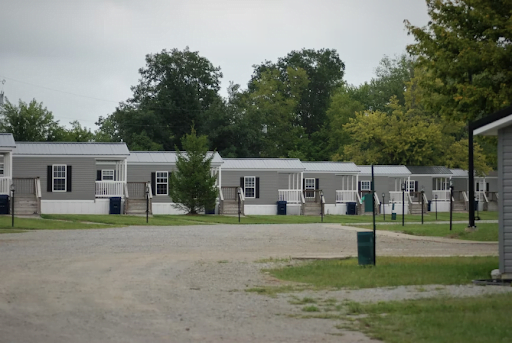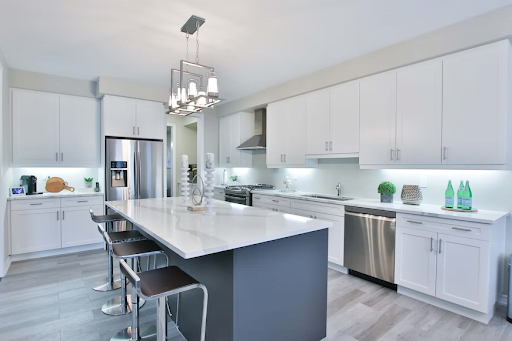
It may be surprising for many people to learn that mobile homes date all the way back to the 1870s. While these prefabricated houses can often get a bad reputation, they have come a long way since their origins.
If you’re considering a mobile home, you might be curious about their history and vast improvements since they were originally created. You might also be researching things like the best insurance for mobile homes so you can get a lower rate.
There are pros and cons to purchasing a manufactured home. But their exciting history may help shed some light on these cost-effective dwellings.

Mobile Homes Make Their Appearance on the East Coast
The first mobile homes in the U.S. were not what you might consider mobile today. In the 1870s, people were building homes in the Outer Banks close to the Atlantic Ocean.
As the tide rose, horses would move the beach dwellings back to avoid flooding. Once the high tide was over, the homes would be moved back to their previous location. These original mobile homes didn’t move more than a few feet.
The introduction of the automobile was the turning point for mobile homes. No longer reliant on horses, people could travel with much more ease. From this desire for travel, mobile trailers were born. People could pull them behind their vehicles to camp for a weekend and escape the city.
It was from these travel trailers that the mobile homes we know today came to be. After the Second World War, soldiers came home in need of a place to live. These trailers were a cheap and easy option that was readily available. From this, the modern mobile home was born.
Adding Size, Space, and Amenities to the Mobile Home
Original mobile homes were not very large. Since they were meant to be pulled behind cars, their size and weight were minimal. When veterans returned home from war, the dimensions of these travel trailers needed to be increased to accommodate full-time living for them and their families.
Trailer sizes went from 20 feet long to 30 feet long. Builders included separate bedrooms to accommodate families. They also added bathrooms, as original travel trailers were often manufactured without plumbing.
Manufactured homes continued to grow in size and amenities over the next few decades. While you may be thinking of a modern mobile home, we are still not there. Even though these manufactured homes were large enough to have multiple stories, they still resembled an RV more closely than a modern mobile home.
Safety Takes a Front Seat for Mobile Homes
These mobile homes were being built by multiple companies without safety regulations for almost three decades. It wasn’t until 1976 that Congress passed the National Manufactured Housing Construction and Safety Act. With this, all prefabricated homes needed to meet national standards before being sold.
Before this act, companies often built mobile homes with cheap materials and little care. This caused them to earn somewhat of a bad reputation. While they were affordable, they were also poor quality.
The companies determined that a rebrand was in order with the safety act passed. Rather than being called mobile homes, they would now be referred to as manufactured homes. A manufactured home must be built in a factory and meet federal standards for building.
This rebrand and new regulation created the modern version of mobile homes many people see today.
Improvements to Manufactured Home Building Materials
Since 1976, the quality of manufactured homes has significantly increased. Builders now must follow guidelines on essential aspects of manufactured home construction, such as size, ventilation, and ceiling height.
In fact, some may argue that these homes are built better than stick-built homes, as they follow a federal standard rather than local standards. These standards cover potential problems like fire safety, heating, and plumbing.
Energy efficiency has also made its way into manufactured homes — some are even Energy Star Certified. It was a common problem for these homes to have extremely high energy bills due to poor building materials.
With better materials, owners of manufactured homes can spend less on their energy bills. Inclusions such as energy-efficient windows, better water heaters, and more insulation have helped these homes get up to par with their stick-built counterparts.
You can guarantee your building materials will be safe from the elements when purchasing a manufactured home, allowing them to be properly treated before exposure. Since they are created in a factory setting, you can avoid the weather wreaking havoc on your building process.
Concerns Still Remain for Manufactured Homes
Though there have been great strides for mobile homes in the last 150 years, they are still not without their cons. Insurance companies may often see manufactured homes as a more significant liability than stick-built homes.
While these homes are built to federal standards, they are still more susceptible to fire damage, frozen pipes, theft, and other risky scenarios than traditional homes. Because of these high risks, insurance companies will often charge more for coverage of modular or manufactured home insurance.
On top of the higher risk, there is also the stigma surrounding mobile homes. Many people see them in a poor light, even though they have come a long way. It’s not uncommon for buyers to avoid manufactured houses altogether when considering their next home due to the reputation they hold.

Continued Growth for Mobile Home Living
Today, 17.7 million people live in manufactured homes in the U.S. That number will likely continue growing as these homes make bigger and better improvements. Even if they don’t have their own piece of land, they have an option of renting a lot for mobile homes.
Although the stigma of manufactured housing still exists, many people have come to look past it and see the beauty mobile homes have to offer. These houses have made considerable improvements in the last century and a half, from elegant finishes to modern floor plans.
It may be hard to believe the stunning designs seen today once started as beach homes pulled by horses to avoid high tide. But the history of the mobile home is unique and filled with unexpected strides.
If you’re considering a manufactured home for your next purchase, consider all the improvements they have made and will likely continue to make in time. They may have a reputation, but they are quickly shedding it for new and improved recognition.
 Alexandra Arcand writes and researches for the insurance comparison site, ExpertInsuranceReviews.com. She is a home expert who enjoys sharing her knowledge with others.
Alexandra Arcand writes and researches for the insurance comparison site, ExpertInsuranceReviews.com. She is a home expert who enjoys sharing her knowledge with others.
I'm so excited to tackle all my home improvement projects! From plumbing to DIY and cleaning - I'm ready to get down to work! #homerepair #homecleaning #plumbing #diy #fixerupper #realestate #renovation #interiordesign #farmhouse #diy #homedecor #hgtv #home #farmhousedecor #modernfarmhouse #farmhousestyle #fixerupperstyle #fixandflip #homerenovation #realestateinvesting #beforeandafter #homesweethome #remodel #realestateinvestor #interior #realtor #joannagaines #flippinghouses #countryliving #design #homedesign #farmhouseinspired #investmentproperty #bhghome #renovationproject #farmhousekitchen #homeimprovement #farmhouseliving #cottagestyle #decor #realestateagent #magnoliahome #homeinspo #magnoliamarket #kitchendesign #dreamhome #shiplap #construction #houseflipping #investor #farmhousedesign #architecture #farmhousechic #homereno #rusticdecor #reno #kitchenremodel #webuyhouses #magnoliatable #rentalproperty #fixerupperinspired #newhome #interiors #homeremodel
